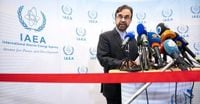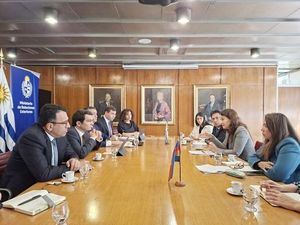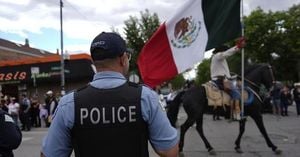As the specter of renewed United Nations sanctions looms large, Iran and the International Atomic Energy Agency (IAEA) have entered a critical new phase of diplomatic engagement. In Vienna on September 6, 2025, Iranian officials and representatives from the UN nuclear watchdog convened to hammer out the contours of what both sides now acknowledge must be a fundamentally new framework for cooperation—a process fraught with uncertainty, urgency, and the weight of global scrutiny.
The backdrop to these talks is anything but routine. According to Mehr News Agency, Reza Najafi, Iran’s Ambassador and Permanent Representative to International Organizations in Vienna, described the latest round of negotiations as pivotal. “These negotiations are aimed at continuing consultations between Iran and the IAEA to define cooperation under the new conditions set by Iran’s Parliament,” Najafi told Iran’s state broadcaster IRIB. The talks, he explained, will clarify both the scope and the nature of future engagements—a task made all the more complex by recent developments in the region and mounting international pressure.
It’s not just the technicalities of nuclear oversight at stake. The political climate has grown tense, with Europe, Israel, and the United States all watching closely. Just days earlier, on September 4, Iranian Foreign Minister Abbas Araghchi met with EU foreign policy chief Kaja Kallas in Doha, as reported by Al-Monitor. Their discussion focused on the rapidly evolving situation surrounding Iran’s nuclear program and the broader diplomatic efforts to prevent a re-escalation of sanctions that could further destabilize the region.
Araghchi was unequivocal in his message: “Tehran will not expand cooperation with the IAEA unless a new agreement is reached.” He pointed to the recent 12-day conflict, during which Iranian nuclear facilities reportedly came under attack by Israeli and U.S. forces, as a watershed moment. “The Agency has also accepted that the current circumstances require a new framework,” Araghchi asserted, highlighting a rare moment of alignment between Iran and the IAEA on the need for a fresh approach.
The urgency is palpable. On September 5, just one day before the Vienna meeting, Iranian and IAEA officials gathered as the so-called UN sanctions “clock” ticked ever closer to midnight. The fear among Iranian leaders is that, should talks falter, the snapback mechanism could trigger the automatic re-imposition of UN sanctions—a scenario Tehran is desperate to avoid. As Araghchi stressed, “Iran will do everything to prevent the re-imposition of UN sanctions under the snapback mechanism.”
Yet the path to a new agreement is anything but straightforward. Iranian sources told Al-Monitor that both sides had agreed to continue consultations in the coming days, signaling that a breakthrough remains elusive. The EU’s Kaja Kallas, for her part, urged patience and dialogue, emphasizing the need to “keep diplomacy open and allow more time for dialogue.”
At the heart of the current impasse is a fundamental question: under what terms will Iran permit international monitoring of its nuclear activities going forward? According to Najafi, the Vienna talks are designed to “determine the new framework of cooperation between Iran and the IAEA,” a process that will define the parameters for technical inspections, information sharing, and compliance verification. The Iranian delegation, he noted, is engaging at the expert level—a sign that both sides are digging deep into the technical and legal details that will underpin any future arrangement.
But the stakes are not only technical; they are deeply political. The Iranian Parliament has laid down new conditions for cooperation, reflecting domestic pressures as well as a desire to extract greater concessions from the international community. For Iran, the memory of sabotage and attacks on its nuclear infrastructure is fresh, and the leadership is determined to secure guarantees against future threats before committing to expanded oversight.
“No new cooperation will be there until the negotiations are concluded,” Araghchi reiterated in comments quoted by IRNA. His words echo a broader sentiment within the Iranian government: that the status quo is untenable, and any further engagement with the IAEA must be predicated on mutual recognition of the new security environment.
The IAEA, for its part, appears to have recognized the shifting dynamics. According to both Iranian officials and international observers, the Agency has agreed that “new developments require a new framework of cooperation.” This admission marks a significant departure from past practice, when the IAEA’s role was largely defined by longstanding agreements and established protocols. Now, both sides are charting unfamiliar territory, with the outcome far from certain.
Meanwhile, the international community remains on edge. European governments, in particular, are pushing for a “negotiated solution,” wary of the consequences that a breakdown in talks could bring. The threat of the snapback mechanism—whereby previously lifted UN Security Council resolutions could be reinstated—hangs over the proceedings like a sword of Damocles. For Iran, the economic and diplomatic costs of renewed sanctions would be severe, potentially undoing years of painstaking negotiation and jeopardizing any hope of broader regional stability.
Yet, for all the tension, there is still a glimmer of hope. The willingness of both Iran and the IAEA to acknowledge the need for a new framework suggests that diplomacy is not yet dead. The expert-level discussions in Vienna are a sign that, while political leaders set the broad contours, the technical experts are hard at work trying to find common ground. As Najafi put it, the goal is to “clarify the scope and nature of future engagements”—a task that will require patience, creativity, and, above all, trust.
For now, the world watches and waits. The coming days and weeks will reveal whether this latest round of talks can yield a breakthrough, or whether the clock will run out, plunging the region—and the world—into a new phase of uncertainty. As the negotiations continue, one thing is clear: the stakes have rarely been higher, and the outcome will reverberate far beyond the conference rooms of Vienna.
With both sides digging in and the shadow of sanctions looming, the outcome of these talks will shape not just the future of Iran’s nuclear program, but the broader trajectory of international diplomacy in a region where every move is watched—and weighed—by the world.




